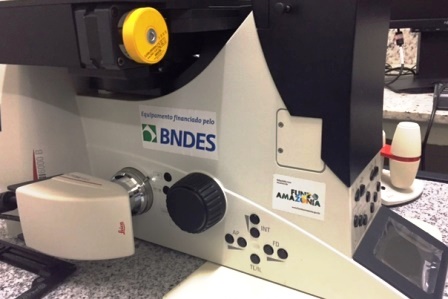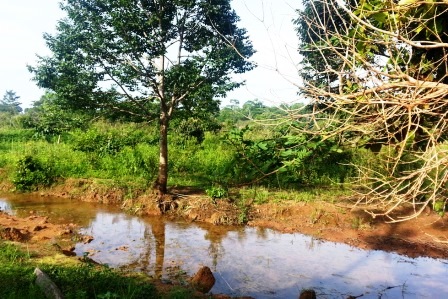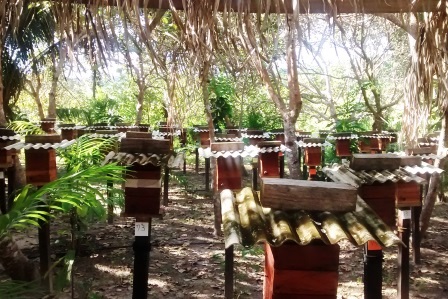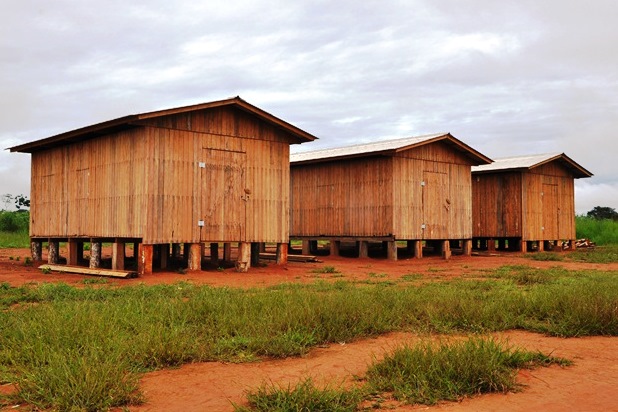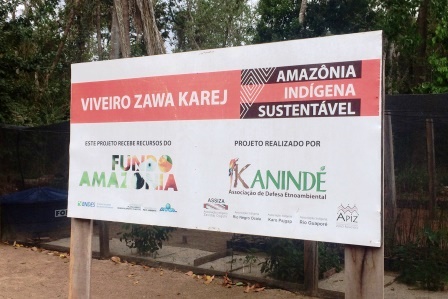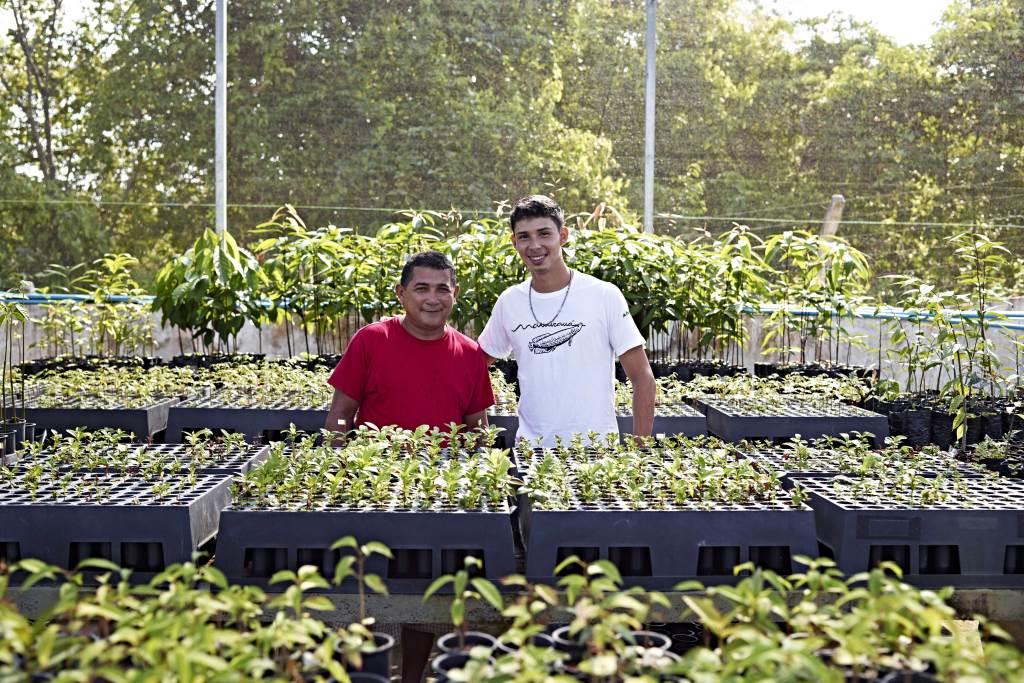Result and impact indicators
The Dema Fund project activities contributed to the results related to the “Sustainable Production” component (1) of the Amazon Fund Logical Framework.
Direct effects 1.1 – Economic activities of sustainable use of the forest and biodiversity identified and developed as an affirmation of the way of life of the forest peoples; and 1.2 – Chains of agroforestry products with expanded socioeconomic value and enhancing the food and nutritional security of the forest peoples.
The main indicators used to monitor these objectives were:
- Average income of families benefited by small projects with economic activities of sustainable use (outcome indicator)
Target: not defined | Result achieved: R$ 2,000 per family
- Revenue obtained by families benefited by small projects with economic activities of sustainable use (outcome indicator)
Target: not defined | Result achieved: R$ 3.9 million
The production of 1,031 families sampled with productive projects (of the total of 2,627 benefited families) totaled an estimated revenue of R$ 2.1 million (R$3.9 million estimated for all the supported sub-projects). The total income per beneficiary family was around R$ 2,000 during the implementation of the project and the production of the largest portion of the sub-projects was concentrated in the period 2015-2017.
- Insertion in the local market of agroforestry products resulting from small projects (outcome indicator)
Target: not defined | Result achieved: 63% of production
On average, 63% of the production was sold and the remaining portion was used for subsistence consumption. For commercial value, we highlight the production of pulp of various fruits, such as acerola, pineapple, buriti, cupuaçu, graviola, mango, and passion fruit, which reached the volume of 120 tons by the end of the project. Twenty-seven
thousand liters of açai pulp, 1,600 liters of various oils (andiroba, babassu, Brazil nut and copaíba), 92 thousand liters of cassava flour, 15 tons of Brazil nut, as well as babassu mesocarp flour, fresh fruits, vegetables, and free-range chicken were also produced.
It is worth noting that the results obtained with expansion of sustainable production had a direct impact on the food and nutritional security of families. The executors of the sub-projects also reported that the organic production valued the native products and that the supported sub-projects helped to recover varieties that were disappearing.
Direct effect 1.3 – Enhanced technical capacity within the scope of forest peoples’ organizations for the deployment of agroforestry systems, forest management activities, agroextractive production, territory management, land regularization, and processing of agroforestry products.
The indicator agreed to monitor this objective was:
- Number of individuals trained in SAFs, forest management, agroextractive production, land management, land regularization, and processing of agroforestry products (output indicator)
Target: not defined | Result achieved: 2,842
In addition to the training workshops to prepare sub-projects and monitoring, 346 events were recorded in a decentralized manner in the 112 sub-projects supported. In total, 2,842 people participated in at least one course or collective work meeting, of which 1,578 were men and 1,264 were women.
It is worth highlighting the relevance of gender in the execution of this project. Of the total of 5,448 people directly benefited in 33 municipalities in the state of Pará through the 112 sub-projects implemented with the coordination of Fase, 46% were women who play a relevant role in the management of production spaces and community coexistence made possible by the project.
Direct effect 1.4 – Deforested and degraded areas recovered and used as instruments of permanence and guarantee of the territories of the forest peoples in the Amazon of Pará.
The indicator agreed to monitor this objective was:
- Areas recovered from the “small projects” supported by the Dema Fund
Target: not defined | Result achieved: 886 ha
The systematization of the results of the project revealed that, even in initiatives whose objective was to recover degraded areas, an increase in the use of new techniques or the revival of traditional sustainable techniques was observed, including the use of vegetation cover and organic biomass to protect the soil, the production of organic
feed for fish and birds, and organic gardens in the “mandala” system, adding poultry and beekeeping.
Deforestation in the state of Pará in 2011 was 3,008 km², while, in 2020, 5,257 km² were deforested. Projects that promote the valorization of the standing forest, by itself, do not have the capacity to change the dynamics of deforestation, needing to be integrated with additional environmental inspection and deforestation control actions.
Institutional and administrative aspects
The execution of the project required an effort to coordinate and articulate partnerships by Fase, responsible for executing the public calls. The organizational and governance structure of Fase/Dema Fund was fundamental to prevent the capillarity and territorial distribution of the sub-projects from making their proper management unfeasible. This
was possible due to the presence of several organizations with a thematic or territorial focus in the Management Committees of the Dema Fund.
The main partner organizations were the Living, Producing, and Preserving Foundation (FVPP) and the Xingu Prelature of the Catholic Church in the area of the Transamazon/ Xingu highway; the Pastoral Land Commission (CPT – Prelature of Itaituba) and the Union of Rural Workers (STTR) of Itaituba around the BR 163 highway; the Support Center for Community Action Projects (Ceapac) and the STTR of Santarém in the Lower Amazon region; the Coordination of the Associations of the Remaining Communities of Quilombos of Pará (Malungu), in performance with the Quilombola
populations; and the representation of the Indigenous Pastoral of the Prelature of Itaituba and representation of the indigenous organizations of Terra do Meio and IL Baú in the relationship with indigenous populations.
This set of partner entities helped the organizations proposing the sub-projects in promoting the necessary contacts and understandings with the government institutions of the regions, such as prefectures, universities, Incra, ICMBio, Ibama, Embrapa, Technical Assistance and Rural Extension Company (Emater), and the National Indian Foundation (Funai). Along with Fase, all this articulation ensured execution of the project in a large geographical area with different socioeconomic situations and, in many cases, in the absence of adequate transport infrastructure and services.
The project benefited from cooperation with the State Secretariat for Environment and Sustainability (Semas) of Pará in the timely examination and dispensation of an environmental license for sustainable projects without the risks of environmental impacts, which was facilitated through the implementation of an internet website.
It should be noted that the Ford Foundation fulfilled a strategic role in preparing and executing this project, especially in supporting the specific Management Committees for Quilombola and indigenous populations.
Risks and lessons learned
The results of the set of supported community sub-projects indicate that the “Dema Fund” project satisfactorily implemented the planned activities and achieved good results. It is a project that reinforces the role played by local populations in the protection and sustainable use of forests as well as in the local supply of good quality food. Indigenous peoples, Quilombola (former slaves) communities, agroextractivists, and family farmers living around the forests, when encouraged to diversify their crops, implement new activities or revive ancestral practices in the sites, respond with diversified production, taking into account their interests and their specific needs.
The realization of public calls for sub-projects in indigenous areas was a great challenge, especially because the execution period of the project coincided with the construction of the Belo Monte hydroelectric plant in the Xingu region. The significant compensatory resources required from the entrepreneurs of that project discouraged the demand for sub-projects with the Dema Fund, which led the Management Committee to give up making a second public call on the subject.
Another lesson of the project is that small collective initiatives generate important changes in local communities due to the participatory approach that puts rural and forest populations and their local organizations in the spotlight. The training offered and the management techniques learned allow these community organizations to escape informality, which represents a decisive factor in the sustainability of the projects.
Sustainability of results
The project benefited from an independent external evaluation contracted by Fase and completed in 2017. In general, the sustainability of the sub-projects was evaluated as positive, based on some factors considered decisive in its execution and management: (i) the strong emphasis on strengthening the capacities of local actors and encouraging joint work between families; (ii) the high level of integration of projects in communities, and it should be noted that one of the principles was not to approve proposals that demonstrated excessive participation of external advisors; and
(iii) the significant participation of women and the appreciation of initiatives based on community and traditional knowledge and values.
On the other hand, the weaknesses existing in the communities and the already highlighted pressures of the surroundings weigh against the sustainability of the initiatives. As challenges, the need for continued technical assistance, the difficult access to electricity, and the difficulties with transportation and repair of equipment were also pointed out.
Finally, it should be noted that a second Amazon Fund support operation was concluded in 2018 to carry out new public calls for sub-projects. The new operation, which planned to allocate 60% of the contracted amount to the consolidation of the initiatives that have achieved a satisfactory result in this project, is in execution and represents an additional support to the sustainability of the implemented actions.



